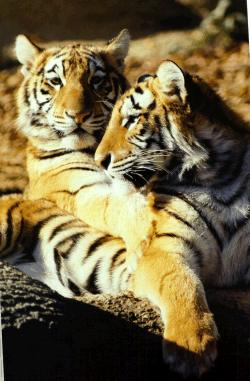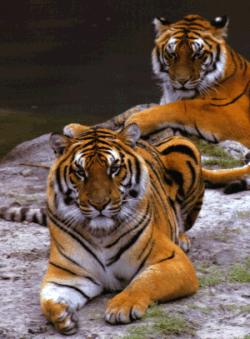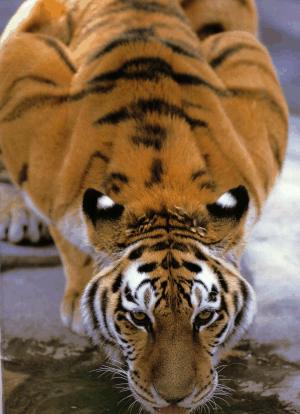


The Eternally Mysterious And Beautiful Animal Beyond Words:
 |
 |
 |
The Siberian - Bengal - Sumatran - And The White Tiger
See this wonderful tiger with itīs beauty, grace and red eyes like fire, and the sight will not be easily forgotten! The tigers body is thickly yet exquisitely designed, the steely muscles in back and shoulders rippling in movement, the huge legs propelling it so smoothly and quietly above the jungle floor!
This animal measures up to thirteen feet and is weighing as much as seven hundred pounds! It has been known to bring down adversaries as big as the elephant and the rhinoceros!
There were once eight subspecies, or races, of the tigers in the world. No comprehensive data exists, but it is estimated that the tiger population before 1900 numbered in the hundreds of thousands. Now several subspecies--the Caspian tiger, the Javan tiger, the Balinese tiger -- are extinct, gone forever! :-(
Of the five remaining subspecies (the Bengal, Chinese, Corbettīs, Siberian and Sumatran) the Chinese tiger is down to perilously low numbers, and in the wild, the Siberian remains at great risk, with perhaps only two hundred tigers remaining. The total population of non-captive tigers in their natural habitat is now approximately nine thousand. But never the less, these are hopeful numbers compared to statistics of a few decades ago!
 |
 |
Tigers tend to be solitary creatures, meeting with their own kind only for mating purpose. They will, however, "socialize" at a site with a plentiful food supply and will share a kill without complaint! The two Bengal tiger on the left looks like a familiar scene to anyone whoīs owned a pair of housecats. Like the domestic feline, these Bengal's have an obsession with cleanliness and will give each other a fairly thorough grooming!

The status of the tiger has been greatly improved in recent decades.Twenty years ago, tigers in the wild faced complete worldwide extinction. The drawing realization that these unique and beautiful animals might cease to exist galvanized an international effort to save them, with governmental , organizational, and individual contribution of labor , money, and ideas!
Much has been done since the beginning of that initial period of enlightenment. But much more remains to be done, and projections by population-biology theorists suggest that the chances of the tiger living another century remain slim. The work which has been done in the past twenty years has only been a stopgap, extending the speciesī life but not guaranteeing their future. Several tiger subspecies has become extinct. It has been only a few years since the Javan and the Balinese tigers faded into legend. The Indonesian government had taken measures to protect the remaining animals, but it was too little, too late! The Javan tiger, which has traditionally symbolized natures power, now symbolizes natureīs fragility. Efforts are now under way in the Soviet Union and in China to save their dwindling tiger populations. It seams highly unlikely that the tiny number of Chinese tigers left will ensure that subspecies survival. The future of the Siberian is equally dispiriting.
The passing of laws to protect the tigers and the establishment of regulated tiger reserves is not enough to guarantee protection. Many of the reserves in India may prove to small or to isolated for their tiger population the reproduce successfully. When a reserve is surrounded by cultivated farm lands and human population, the tigers are isolated, in essence trapped. This can lead first to deadly fights over territory. Secondly, it leads to the elimination of genetic diversity. Under ideal circumstances, young tigers would leave the areas, expanding the genetic mix. When hemmed in, these tigers begin mating with family members, parents with offspring, brother with sister. Such continued inbreeding eventually leads to fewer offspring, a susceptibility to diseases, and other problems , eventually leading to self-destruction!
Happily, the tigers future does not look entirely bleak. There are many signs of hope in the world of tiger conservation, and scientific developments may soon be able to increase immeasurably the tigerīs chance of survival.
Researchers and captive-breeding specialists have been experimenting for years with techniques for the artificial insemination of tigers. on April 27 , 1990, at the Henry Doorly Zoo in Omaha, Nebraska, the worlds firstītigers conceived by in-vitro fertilization were born. The sperm of a white male tiger was mixed with the eggs of a Bengal tigress and implanted in a nine year old Siberian surrogate mother named Nicole. Delivered by Cesarean section, the litter consisted of a white male cub and normal-striped male and female twins. The white male died shortly after birth, and the male twin expired some month later, but the third cub is healthy and growing at the writing. With this breakthrough, scientists can now look forward more optimistically to a time when the same artificial-insemination process can be done in the wild, allowing genetic exchange and replenishment among the tiger population in the reserves, particularly those in tightly circumscribed surroundings.
With the dwindling wild population of all subspecies expect for the Bengal, the future of the tiger in the wild has been left almost entirely to the government of India. Whatever scientists come up with in other parts of the world, it will still depend on the corporation and interest of India and the Indian people.
In India "Project Tiger" is a very important mission. The tiger is Indiaīs National animal, and they say:

The tiger has become a symbol of the fragile existence of even the strongest members of the animal kingdom in our world, and I dearly hope that there will be taken prompt action to ensure their survival, and that we havenīt taken a last glimpse of these beautiful creatures in all their glory!